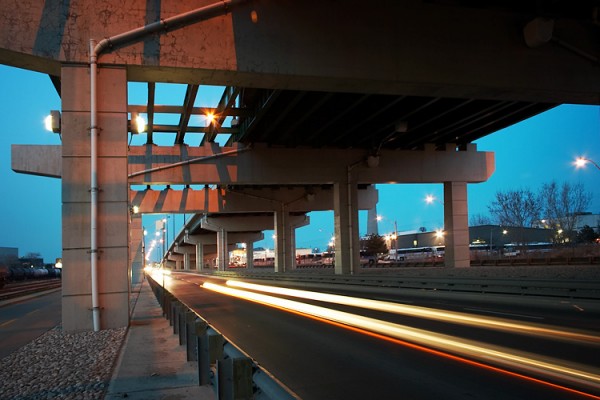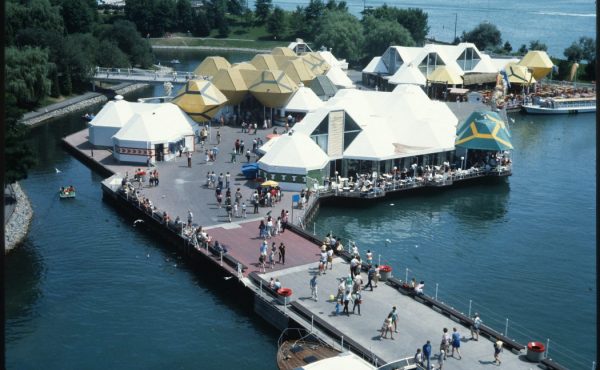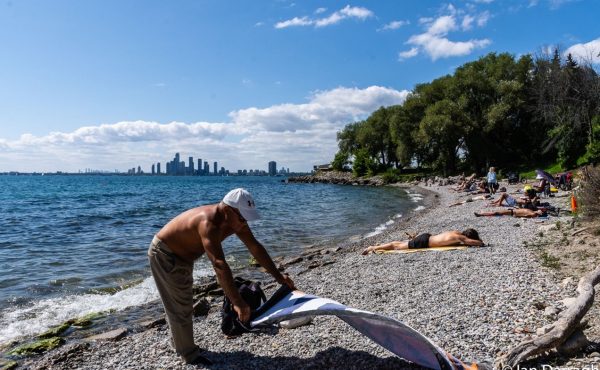I’d like to pose an impolite question to the talented officials at Waterfront Toronto (WT) and their dedicated colleagues in the City’s waterfront planning group:
Are you guys nuts?!?
At last week’s open house about the future of Gardiner Expressway’s east end, WT and City officials (and a small army of planning consultants) laid out some of the latest thinking about the various options under consideration (“maintain,” improve,” “replace”, and “remove”), as well as the process for making an inarguably historic decision about Toronto’s monument to 1950s transportation planning.
While deputy city manager John Livey took care to explain that a final verdict won’t be forthcoming until at least 2015, he did say WT and City officials plan to ask council to weigh in on a “recommended preferred alternative” next spring.
And yes, they all know there’s going to be an election going on.
Which brings me back to the aforementioned rude question….
There’s little doubt the members of the WT/City Gardiner East team have been thinking hard and seriously about this issue, which involves significant amounts of public money, extensive consultation, intricate ideas about land use and epic civil engineering challenges. Not content to labour away in an ivory silo, these experts are keenly aware that the Gardiner EA is tethered to the results of a wide range of parallel studies involving the waterfront and its transportation networks.
So why they’d risk asking the current council to absorb all this higher-order thought is totally beyond me.
After all, this group — with a very few notable exceptions — has displayed an utterly appalling inability to treat serious city-building issues seriously. They’ve flip-flopped on the transit file like a half-dead fish on a dock, and they’ve demonstrated eye-watering inconsistency on the small matter of paying for large capital projects.
Then, of course, there’s Mayor SubwaySubwaySubway, who has neither the interest nor the intellectual wherewithal to grasp any of officialdom’s fine-grain analysis about the Gardiner’s future. As sure as Tuesday follows Monday, Ford can be counted on to make many public-opinion-swaying grunting sounds about wars on cars and other fictions. Indeed, I’d argue that by aiming to get the Gardiner on council’s agenda in the spring, the WT/City team will be effectively jamming a stick in that hornet’s nest otherwise known as Ford Nation. As if another one is needed…
Yes, it is possible that the WT/City’s preferred option will be a status quo scenario — repair the rebar, patch the concrete, slap on a fresh coat of paint, etc. — which meets Ford’s cost threshold and his always nuanced grasp of transportation policy. But if they align around another idea(s), Ford gains yet another phoney target for his invective, and the public conversation becomes that much more debased.
I don’t mean to suggest that the whole city should cower in the face of Ford’s boundless rhetorical stupidity. But much is riding on this election, whereas the Gardiner is a slow-moving story that just kind of trudges along. At the very least, we don’t need to turn the deliberation over its future into an election issue.
The reason is that the WT/City planners have come up with an intriguing — though certainly not perfect — approach to rethinking the Gardiner corridor that merits serious technical and political attention.
As regular readers of this space will know, I’ve never been convinced by the case for removing the Gardiner, simply because the resulting surface road — an eight-to-ten lane behemoth shoe-horned between the backs of development parcels and the railway embankment — hardly strikes me as an improvement. The WT/City presentation, however, claims that removing the Gardiner will produce a significant updraft in property values (the deck estimates about 30%, but no sources are given) as well as an increase in real estate with development potential.
The WT/City consultants are also exploring the possibility of stripping the two centre lanes out of the existing Gardiner and then slimming the footprint of Lake Shore Boulevard so it doesn’t spill out from underneath the el’ — the so-called “improve” option. As was explained last week, the gap would allow sunlight to reach Lake Shore and the area just to the north. The slimmed down Lake Shore, in turn, opens up about 500,000 sq.-ft of turf for development or public space.
Based on the presentation, I can’t yet judge if this approach is realistic from an engineering point of view, or cost effective (i.e., will development on those new parcels off-set the cost of shifting Lake Shore and splicing the Gardiner). It’s also difficult to discern whether the new land created will be desirable. But I want to learn more, which is why I’d prefer that the debate take place outside silly season.
Moreover, the question of money will inevitably arise, and I’d like to see the WT/City team present council with a more expansive decision-making framework — one that takes into account the opportunity costs for other waterfront projects.
The WT/City team estimates that the “improve” option would cost $420-$630 million — the second most expensive alternative, after replacing the Gardiner with a higher and slimmer highway. (Maintaining it will cost $230 million, while removing the el’ and building a wide boulevard runs from $240 to $360 million).
From where I sit, the key equation is this: if we add the cost of fixing the Gardiner to the (as-yet-unfunded) $500-$600 million needed to re-build the mouth of the Don as a means of dealing with the floodplain issues on the Portlands, and if then we compare that total outlay to the development/economic/quality of life potential of the two projects combined, what is the optimal use of public resources?
After all, the really big prize in the waterfront is a creative re-purposing of the Portlands, and it’s reasonable to argue that dollars invested in the Gardiner/Lake Shore corridor are dollars that won’t be used for mouth of the Don.
Complicated, huh? Lots of interconnected moving parts, right?
All the more reason not to sacrifice this debate to an election that, I’m afraid, will almost certainly drag Toronto’s public discourse down to new lows.
photo by Sam Javanrouh






9 comments
Finally an opinion piece that says it like it is when it comes to our Mayor Rob Ford and the current Toronto City Council.
“Lots of interconnected moving parts”
The most obvious connected parts are the East and West Gardiner. By considering only the East, it prevents a comprehensive grand plan from being created.
Think about the tunnel option. From the DVP, to go above the Don River, then go underground and then come back up to elevated Gardiner level at Jarvis would be like a roller coaster. If it went all the way to the at-grade portion at The EX, it might achieve the benefits that a true tunnelled solution would give.
The same thing applies to the Replacement option above the railway. Unless it can traverse the entire downtown from Strachan to DVP, the benefits are greatly reduced.
TLDR: Toronto City Council is incapable of providing direction on this project and the Toronto Waterfront planning group that has spent millions of taxpayer dollars on project planning has now deferred to Toronto City Council to provide direction on the final decision during an election year.
As such, instead of making an informed, forward thinking decision based on years of research and planning, the fate of the Gardiner Expressway will be ultimately decided by a popularity contest during the next election.
This type of decision making by Toronto City Council has proven to be a disaster for the city. For example City Council’s recent decision to cancel an expansive “Transit City” project that would have linked up the entire city via a light rail system, in favour of a short 3-stop subway expansion that will cost taxpayers a billion dollars per stop.
Unlocking development also unlocks the need for more transit (which includes cars and TTC/GO). In many ways the Gardiner actually works really well right now. I say fix it up or bury it. We need an east west road without traffic lights or this city will choke.
My personal opinion is that the city has made a mistake by only looking at only the eastern section from Jarvis to the DVP rather than the elevated portion of the Gardiner as a whole. Even more sad is that this is not coming as part of a greater holistic examination of transportation and movement in the growing waterfront+railway+portlands area.
It’s quite clear that Toronto is only looking at the Gardiner (and only this portion) because they have to, given that:
1) it is falling down.
2) some maintenance has obviously not been handled properly
3) there was no long term plan for the Gardiner anyways.
Of the 4 options I would aim for the remove, but with a roadway no larger than 8 lanes, and with provisions for the median lanes to be replaced by:
A) LRT
B) inhospitable parks and monuments, just like University Ave north of Richmond (which is actually two north-south roads made into one).
In an ideal world I would bore a large (10-12m in diameter) tunnel from Jameson under the Exhibition grounds and Lakeshore Boulevard all the way to the Don River.
By making the tunnel this large there would be enough room to have 2 decks for traffic, and ramps could be configured to have a smaller footprint. The bottom section of the tunnel would be a massive drain, capable of carrying away water from flash floods, and of course the tunnel would last 100 years.
I would extend Fleet Street to Dufferin and reconfigure the streetcar access to the Ex Grounds, connecting the Exhibition and Dufferin loops.
And of course I could do all of this because private developers will pay hugely for the the opportunity to build along a grand “Lakeshore Avenue” that is worthy of the name.
I will now take a moment to figure out the line between real ideas and sarcasm in what I have written above.
Cheers, Moaz
After traveling to Asia this fall, and seeing all the solutions to elevated roadways, I think we have it wrong. The problem isn’t the Gardiner, it’s Lakeshore.
I think the best solution is to repair the Gardiner, and focus on Lakeshore. This, as a pedestrian and biker, is what i have the most problem with anyways. I think it should be no more than a two lane road, one per direction, and limited in speed to 40. It should be effectively turned into a local road in these areas. Expand the side walks, add lighting, and make sure there are places on both if sides that people want to congregate in. Possibly add in commercial space for stores, etc, and of course rapid transit. Turning this into a grand avenue like university isn’t a good option IMHO.
I am a firm adherent of tearing the Gardiner down and replacing it with an improved Lake Shore Boulevard. A tunnel is too costly and will never happen, but there is ample real-world evidence of how to make an attractive at-grade high-volume arterial with attractive pedestrian crossings. This is not rocket science, you just need to visit West Street in Manhattan (nee West Side Highway) or Octavia Blvd in SF (nee US 101) to know it can and should be done in Toronto.
To accommodate the difficult construction period, GO Exhibition should be turned into a giant and free commuter parking lot. Long term, better GO service can help take share from those currently commuting into downtown via the Gardiner. But just as in other cities an at-grade boulevard can carry enough traffic to still serve the CBD while removing the ongoing maintenance costs of the Gardiner and its depressing effect on adjacent property value. It’s not a grand avenue, just a prettified limited-intersection pseduo-highway.
I also attended the WT open house.
Up front, I was also dumbstruck by the foolishness of wasting a lot of good thinking (and planning) on a city council in the throws of an election. Such timing might, forever, cast the Gardiner issue in whatever strange light the mayor chooses to shine on it. Better to wait.
With the exception of poor timing, WT’s found a way to present a complex set of issues in a way that the public can contemplate in a careful and informed manner. An idea surfaced at my table which is worth repeating. What if….
We tear down the eastern Gardiner, build 8 or 10 lanes, then cover them with a park at a hight roughly the same as the rail lines. Imagine a park that lifts people and bikes high enough to take in the city and even a glimpse of the harbour. An elevated park would cost much, much less than an elevated road and, really, why leave the air and the spectacular view and the fun to the cars?
Shelley Carroll was there. I mentioned the idea to her and she dismissed it as having been raised by Giorgio Mammoliti. From the mouths of babes sometimes comes brilliant ideas. Sometimes.
Why not tear down the gardiner, rebuild it over the existing rail corridor? And I agree that in the future when more funds are available we should also focus on improving Lake Shore Blvd (which isn’t even a real blvd)